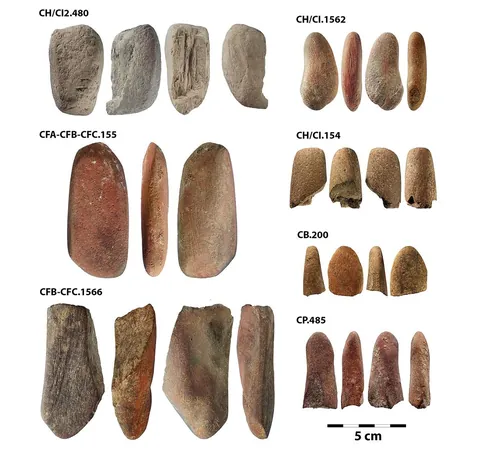
Unlocking the Secrets of Ochre: Early Humans’ Advanced Toolmaking Skills in Blombos Cave
2025-07-01
Author: Daniel
Revolutionary Findings at Blombos Cave
In a stunning revelation, researchers from SapienCE have uncovered that ochre, long believed to be merely a symbolic pigment, was instrumental in the crafting of advanced stone tools by early modern humans in Blombos Cave, South Africa, dating back between 90,000 and 70,000 years ago.
The Discovery That Changed Everything
While analyzing artifacts from previous excavations at the SapienCE lab in Cape Town, archaeologist Elizabeth Velliky stumbled upon an ochre fragment that didn't match the typical marks associated with pigment production. Her curiosity led her to enlist the expertise of colleagues Francesco d’Errico, Karen van Niekerk, and Christopher Henshilwood. Their detailed examination confirmed that the fragment had been meticulously shaped for an entirely new purpose.
A Game-Changer for Toolmaking
Published in *Science Advances*, this groundbreaking study presents the first concrete archaeological evidence that ochre was deliberately fashioned into tools for retouching lithic implements. Experimental work by d’Errico and his team revealed that these ochre “retouchers” were utilized for sophisticated techniques such as pressure flaking and direct percussion—methods known for their precision and skill.
Tools of Trade and Identity
Interestingly, these ochre artifacts displayed signs of care and maintenance, suggesting that they were prized possessions of expert toolmakers. D’Errico remarks, “The complexity of these pressure flakers implies they were not just functional tools but also symbols of identity and skill.”
Rethinking Ochre's Role in Early Human Culture
This revelation challenges long-held beliefs that ochre served only a symbolic purpose related to rituals or body painting. Instead, it highlights its practical versatility. While previous studies hinted at uses in hide tanning or adhesive creation, this marks the first time hard evidence has surfaced.
A Major Leap in Understanding Early Human Behavior
Henshilwood, director of SapienCE, stressed the monumental implications of these findings: “We now have proof that ochre was not just a medium for symbolic expression but also a crucial component in specialized tool production, showcasing a technological sophistication previously attributed to much later epochs.”
Van Niekerk, co-author and head of the Blombos Cave excavations, added that this discovery enriches our understanding of early Homo sapiens and their behavioral complexity. “It will further illuminate the behavioral modernity of early Homo sapiens in southern Africa,” she noted.


 Brasil (PT)
Brasil (PT)
 Canada (EN)
Canada (EN)
 Chile (ES)
Chile (ES)
 Česko (CS)
Česko (CS)
 대한민국 (KO)
대한민국 (KO)
 España (ES)
España (ES)
 France (FR)
France (FR)
 Hong Kong (EN)
Hong Kong (EN)
 Italia (IT)
Italia (IT)
 日本 (JA)
日本 (JA)
 Magyarország (HU)
Magyarország (HU)
 Norge (NO)
Norge (NO)
 Polska (PL)
Polska (PL)
 Schweiz (DE)
Schweiz (DE)
 Singapore (EN)
Singapore (EN)
 Sverige (SV)
Sverige (SV)
 Suomi (FI)
Suomi (FI)
 Türkiye (TR)
Türkiye (TR)
 الإمارات العربية المتحدة (AR)
الإمارات العربية المتحدة (AR)